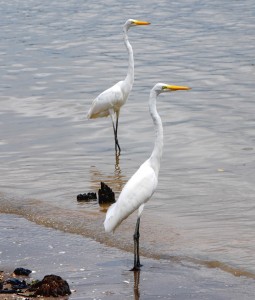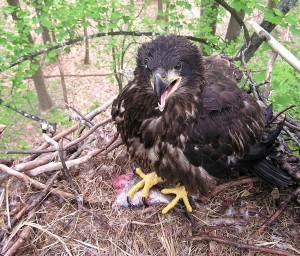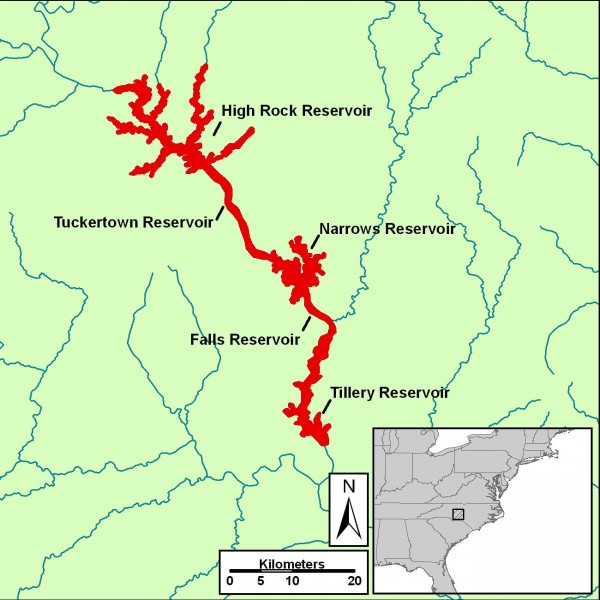Waterbird community expands on the Upper Pee Dee (ALCOA)
Spring shorebird migration along the lower Delmarva Peninsula: the 2010 season
July 3, 2010Virginia Eagle Survey continues to reach milestones
July 5, 2010
Written by Bryan Watts
July 4, 2010

Great egrets seen loafing along the shoreline. In 2004, great egrets colonized a single great blue heron rookery. Now they nest in 4 colonies and are expanding from the coast into the Piedmont is occurring throughout the southeast. Photo by Bryan Watts.
The 2010 breeding season represents the 10th consecutive year that the Center for Conservation Biology (CCB) has conducted aerial surveys for breeding waterbirds in the upper Pee Dee River basin in the Piedmont of North Carolina. The basin supports four reservoirs including High Rock Reservoir, Tuckertown Reservoir, Narrows Reservoir, and Falls Reservoir that are managed by ALCOA for the production of hydro-electric energy. The reservoirs support a growing community of fish-eating birds and are significant within this physiographic province. The survey series represents a view into ongoing population changes for these species within the region.

Eagle chick clutches a fish in a poplar tree nest. Productivity has been good within the reservoir system suggesting that fish availability is adequate to sustain the population. Photo by Bryan Watts.
When the Center first surveyed the reservoir system in 1995 there was a single bald eagle breeding territory on the upper end of High Rock Reservoir. By 2010, there were 9 breeding pairs, including at least one on each reservoir. Eagles have colonized the basin readily and are particularly associated with the dam outflow areas. Adults and young-of-the-year are frequently observed foraging and loafing around the outflows. Productivity has been well above maintenance levels.
Great blue herons have also increased dramatically within the survey area. In 2001, there were only 5 colonies documented that supported 598 breeding pairs. By 2010 there were 14 colonies supporting 1,121 pairs. Most of the colonies occur on small, forested islands. The majority of these islands now support breeding colonies.

Unusual juxtaposition of a great blue heron colony with birds on nests (center of island) ringed by heavy whitewash from cormorants roosting around the perimeter. Cormorant numbers have increased dramatically in recent years. Photo by Bryan Watts.
Over decade of surveys, two waterbird species have colonized the study area. In 2004, great egrets were observed nesting in a single colony of great blue herons on High Rock Reservoir. By 2010, egrets were nesting in 4 colonies and had increased to 61 breeding pairs. In 2010, double-crested cormorants were found nesting for the first time on Badin Lake within a colony of great blue herons.

Tell tale signs of roosting cormorants on forest islands in the upper reaches of Abbott’s Creek. These roost sites stand out in contrast against the winter landscape. Photo by Bryan Watts.
In addition to breeding birds, the system of reservoirs are supporting a rapidly expanding community of non-breeding waterbirds. In addition to large numbers of overwintering gulls and ducks, the reservoirs are now supporting more than 10,000 double-crested cormorants. These birds roost communally on several of the offshore, forested islands and on structures below the outfall of dams. For the past 3 years, 10-20 American white pelicans have been present on the upper end of High Rock Reservoir during the March flight.

Map of the upper Pee Dee Basin in the Piedmont of North Carolina showing the location of reservoirs. Map by the Center for Conservation Biology.
Project sponsored by the Center for Conservation Biology (CCB) and ALCOA.





